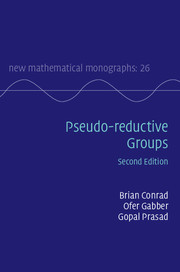Book contents
- Frontmatter
- Dedication
- Contents
- Preface to the second edition
- Introduction
- Terminology, conventions, and notation
- PART I Constructions, examples, and structure theory
- PART II Standard presentations and their applications
- PART III General classification and applications
- PART IV Appendices
- References
- Index
Introduction
Published online by Cambridge University Press: 05 June 2015
- Frontmatter
- Dedication
- Contents
- Preface to the second edition
- Introduction
- Terminology, conventions, and notation
- PART I Constructions, examples, and structure theory
- PART II Standard presentations and their applications
- PART III General classification and applications
- PART IV Appendices
- References
- Index
Summary
Why go beyond reductive groups?
The theory of connected reductive groups over a general field, and its applications over arithmetically interesting fields, constitutes one of the most beautiful topics within pure mathematics. However, it does sometimes happen that one is confronted with linear algebraic groups that are not reductive, and whose structure may be rather mysterious.
Example: forms of a variety. Let X be a projective variety over a field k. Grothendieck constructed a scheme AutX/k classifying its automorphisms, but this is hard to understand in general. For example, finite generation of its component group is unknown, even if k = C. Likewise, little is known about the identity component apart from that it is a k-group scheme of finite type. Since H1 (k, AutX/k) classifies k-forms of X, there is arithmetic interest in AutX/k even though our knowledge of its structure is limited.
If char(k) = 0 then by a structure theorem of Chevalley for smooth connected groups over perfect fields, is an extension of an abelian variety by a smooth connected affine k-group. If k is imperfect then Chevalley's Theorem does not apply (even if is smooth). Nonetheless, some general problems for connected k-group schemes G of finite type (e.g.,) reduce to the cases of smooth connected affine k-groups and abelian varieties over k. We do not know any restrictions on the smooth connected affine groups arising in this way when.
Example: local-to-global principle. Let X be a quasi-projective (or arbitrary) scheme over a global field k. Suppose that X is equipped with a right action by a linear algebraic k-group H. Choose a point x ∈ X(k). Does H(k) act with only finitely many orbits on the set of x′ ∈ X(k) that are H(kv)-conjugate to x for all v away from a fixed finite set S of places of k?
Information
- Type
- Chapter
- Information
- Pseudo-reductive Groups , pp. xiii - xxiiPublisher: Cambridge University PressPrint publication year: 2015
